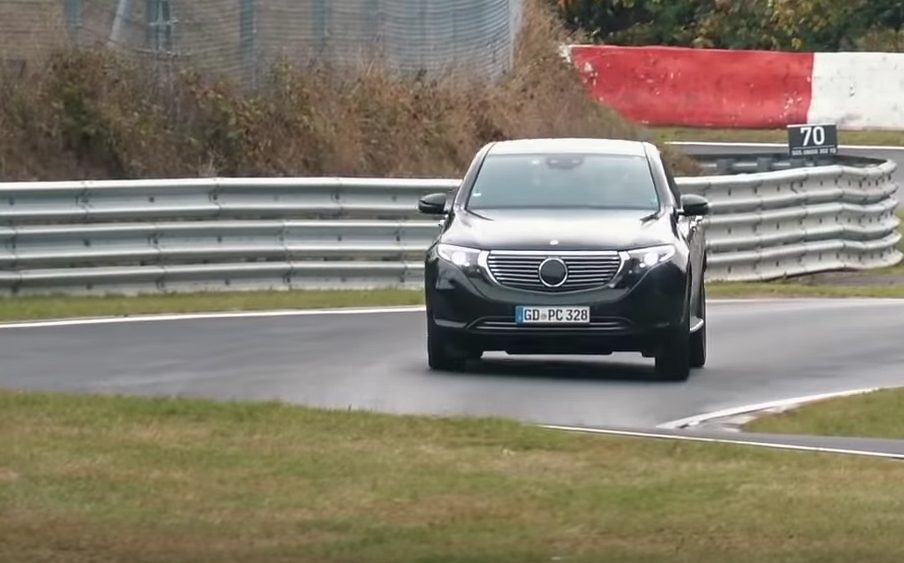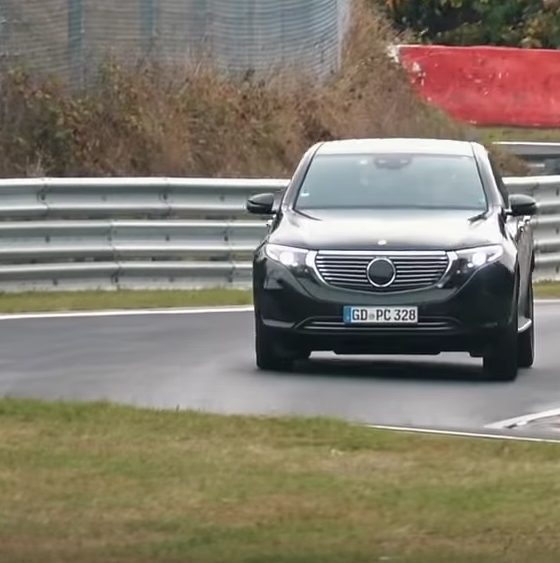

News
Mercedes-Benz EQC shows off its cornering prowess in Nurburgring track tests
German automaker Mercedes-Benz seems to be ensuring that its first all-electric vehicle, the EQC, will be an SUV that can deliver some serious performance. The vehicle might have raised some eyebrows immediately following its launch due to questions about its range and efficiency, but if a video of the SUV taking on the Nürburgring Nordschleife is any indication, it appears that Mercedes-Benz’s luxury EV can be a pretty fun car to drive.
A video of the SUV doing continuous testing was captured by YouTube auto enthusiast Automotive Mike. In the clip, the EQC could be seen hugging the track pretty well. The vehicle’s quick acceleration thanks to the instant torque of its two electric motors was quite evident too. For an SUV that’s large and almost bulky compared to competitors like the Jaguar I-PACE and the Tesla Model X, the Mercedes-Benz EQC seems to be surprisingly nimble.
If there was anything that could be noticed from the video of its Nürburgring runs, though, the EQC appears to exhibit a notable amount of body roll, particularly when cornering at high speeds. While this might allude to the EQC having softly-tuned suspension, such a setup nevertheless points to the all-electric SUV offering its passengers a comfortable ride.
Mercedes-Benz unveiled the EQC early in September, with Daimler AG Chief Executive Officer Dieter Zetsche boldly declaring in front of an audience at Stockholm, Sweden, that the EQC symbolizes the company’s commitment to the electrification of the transport industry. The Daimler CEO even noted that there simply is “no alternative to betting on electric cars.”
The Mercedes-Benz EQC looks and feels like a traditional vehicle from the veteran luxury carmaker, being plush with luxurious accents and designed with understated lines and an aggressive stance. The specs of the car are quite decent, with two electric motors that produce 402 hp and 564 lb-ft of torque. Despite its size and bulk, the EQC is capable of accelerating from 0-60 mph in 4.9 seconds and reaching a top speed of 112 mph. The EQC also has a towing capability of 3,968 lbs.
Inasmuch as the performance specs of the vehicle are impressive, though, the EQC’s battery and range were met with some raised eyebrows from the auto community, after initial press materials quoted the vehicle’s range from its 80 kWh battery pack at just ~200 miles. Mercedes-Benz later corrected the information, stating that the EQC actually has a range of 279 miles per charge.
When the vehicle was announced, Mercedes-Benz announced that it is expecting to start the production of the EQC sometime in 2020. In a later report, though, the legacy carmaker stepped back from its estimates, stating that it was adopting a gradual rollout for the vehicle instead. Speaking to Europe Auto News, Mercedes-Benz head of production and supply chain management Markus Schaefer noted that the vehicle’s more deliberate rollout was due to the company’s concerns about the new technologies in the EQC, particularly in its battery.
“We want to be sure we deliver Mercedes quality from day one in all aspects, and we have to watch the warranty side for customers as well. We don’t want customers ending up at the mechanic later. Slowing down the ramp-up is a tool to make sure we do it right, to address all the unknowns that an electric car brings,” he said.
While electric car enthusiasts who wish to acquire the Mercedes-Benz EQC might end up waiting a little longer for the vehicle, Schaefer nonetheless stated that the company is confident it can ramp the production of the all-electric SUV quickly. The veteran carmaker plans to manufacture the EQC at its facilities in Bremen, Germany, and Beijing, China, on the same line as the company’s gas-powered SUVs such as the Mercedes-Benz GLC.
Watch the Mercedes-Benz EQC take on the Nürburgring Nordschleife in the video below.

Elon Musk
Elon Musk and Tesla AI Director share insights after empty driver seat Robotaxi rides
The executives’ unoccupied tests hint at the rapid progress of Tesla’s unsupervised Robotaxi efforts.

Tesla CEO Elon Musk and AI Director Ashok Elluswamy celebrated Christmas Eve by sharing personal experiences with Robotaxi vehicles that had no safety monitor or occupant in the driver’s seat. Musk described the system’s “perfect driving” around Austin, while Elluswamy posted video from the back seat, calling it “an amazing experience.”
The executives’ unoccupied tests hint at the rapid progress of Tesla’s unsupervised Robotaxi efforts.
Elon and Ashok’s firsthand Robotaxi insights
Prior to Musk and the Tesla AI Director’s posts, sightings of unmanned Teslas navigating public roads were widely shared on social media. One such vehicle was spotted in Austin, Texas, which Elon Musk acknowleged by stating that “Testing is underway with no occupants in the car.”
Based on his Christmas Eve post, Musk seemed to have tested an unmanned Tesla himself. “A Tesla with no safety monitor in the car and me sitting in the passenger seat took me all around Austin on Sunday with perfect driving,” Musk wrote in his post.
Elluswamy responded with a 2-minute video showing himself in the rear of an unmanned Tesla. The video featured the vehicle’s empty front seats, as well as its smooth handling through real-world traffic. He captioned his video with the words, “It’s an amazing experience!”
Towards Unsupervised operations
During an xAI Hackathon earlier this month, Elon Musk mentioned that Tesla owed be removing Safety Monitors from its Robotaxis in Austin in just three weeks. “Unsupervised is pretty much solved at this point. So there will be Tesla Robotaxis operating in Austin with no one in them. Not even anyone in the passenger seat in about three weeks,” he said. Musk echoed similar estimates at the 2025 Annual Shareholder Meeting and the Q3 2025 earnings call.
Considering the insights that were posted Musk and Elluswamy, it does appear that Tesla is working hard towards operating its Robotaxis with no safety monitors. This is quite impressive considering that the service was launched just earlier this year.
Elon Musk
Starlink passes 9 million active customers just weeks after hitting 8 million
The milestone highlights the accelerating growth of Starlink, which has now been adding over 20,000 new users per day.

SpaceX’s Starlink satellite internet service has continued its rapid global expansion, surpassing 9 million active customers just weeks after crossing the 8 million mark.
The milestone highlights the accelerating growth of Starlink, which has now been adding over 20,000 new users per day.
9 million customers
In a post on X, SpaceX stated that Starlink now serves over 9 million active users across 155 countries, territories, and markets. The company reached 8 million customers in early November, meaning it added roughly 1 million subscribers in under seven weeks, or about 21,275 new users on average per day.
“Starlink is connecting more than 9M active customers with high-speed internet across 155 countries, territories, and many other markets,” Starlink wrote in a post on its official X account. SpaceX President Gwynne Shotwell also celebrated the milestone on X. “A huge thank you to all of our customers and congrats to the Starlink team for such an incredible product,” she wrote.
That growth rate reflects both rising demand for broadband in underserved regions and Starlink’s expanding satellite constellation, which now includes more than 9,000 low-Earth-orbit satellites designed to deliver high-speed, low-latency internet worldwide.
Starlink’s momentum
Starlink’s momentum has been building up. SpaceX reported 4.6 million Starlink customers in December 2024, followed by 7 million by August 2025, and 8 million customers in November. Independent data also suggests Starlink usage is rising sharply, with Cloudflare reporting that global web traffic from Starlink users more than doubled in 2025, as noted in an Insider report.
Starlink’s momentum is increasingly tied to SpaceX’s broader financial outlook. Elon Musk has said the satellite network is “by far” the company’s largest revenue driver, and reports suggest SpaceX may be positioning itself for an initial public offering as soon as next year, with valuations estimated as high as $1.5 trillion. Musk has also suggested in the past that Starlink could have its own IPO in the future.
News
NVIDIA Director of Robotics: Tesla FSD v14 is the first AI to pass the “Physical Turing Test”
After testing FSD v14, Fan stated that his experience with FSD felt magical at first, but it soon started to feel like a routine.

NVIDIA Director of Robotics Jim Fan has praised Tesla’s Full Self-Driving (Supervised) v14 as the first AI to pass what he described as a “Physical Turing Test.”
After testing FSD v14, Fan stated that his experience with FSD felt magical at first, but it soon started to feel like a routine. And just like smartphones today, removing it now would “actively hurt.”
Jim Fan’s hands-on FSD v14 impressions
Fan, a leading researcher in embodied AI who is currently solving Physical AI at NVIDIA and spearheading the company’s Project GR00T initiative, noted that he actually was late to the Tesla game. He was, however, one of the first to try out FSD v14.
“I was very late to own a Tesla but among the earliest to try out FSD v14. It’s perhaps the first time I experience an AI that passes the Physical Turing Test: after a long day at work, you press a button, lay back, and couldn’t tell if a neural net or a human drove you home,” Fan wrote in a post on X.
Fan added: “Despite knowing exactly how robot learning works, I still find it magical watching the steering wheel turn by itself. First it feels surreal, next it becomes routine. Then, like the smartphone, taking it away actively hurts. This is how humanity gets rewired and glued to god-like technologies.”
The Physical Turing Test
The original Turing Test was conceived by Alan Turing in 1950, and it was aimed at determining if a machine could exhibit behavior that is equivalent to or indistinguishable from a human. By focusing on text-based conversations, the original Turing Test set a high bar for natural language processing and machine learning.
This test has been passed by today’s large language models. However, the capability to converse in a humanlike manner is a completely different challenge from performing real-world problem-solving or physical interactions. Thus, Fan introduced the Physical Turing Test, which challenges AI systems to demonstrate intelligence through physical actions.
Based on Fan’s comments, Tesla has demonstrated these intelligent physical actions with FSD v14. Elon Musk agreed with the NVIDIA executive, stating in a post on X that with FSD v14, “you can sense the sentience maturing.” Musk also praised Tesla AI, calling it the best “real-world AI” today.








